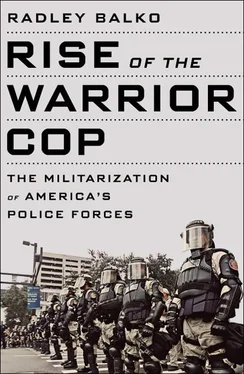In the same speech, Reagan called for expanding the list of crimes for which judges could deny bail, revoking Miranda and the Exclusionary Rule, a major new role for the military in fighting the drug war, an overhaul of the federal criminal code to include dozens of new laws, and in general a massive expansion of the powers and authority afforded to police and prosecutors. Without missing a beat, he then explained that America’s crime problem was not only a moral problem, but a problem inextricably linked to… the expansion of government.
A tendency to downplay the permanent moral values has helped make crime the enormous problem that it is today, one that this administration has, as I’ve told you, made one of its top domestic priorities. But it has occurred to me that the root causes of our other major domestic problem, the growth of government and the decay of the economy, can be traced to many of the same sources of the crime problem. This is because the same utopian presumptions about human nature that hinder the swift administration of justice have also helped fuel the expansion of government. 3
Conservatives had always held the somewhat contradictory position that government can’t be trusted in any area of society except when it comes to the power to arrest, detain, imprison, and execute people. But Reagan didn’t dance around the contradiction, he embraced it. He blamed crime on big government—and in the same breath demanded that the government be given significantly more power to fight it. In words dripping with rectitude, he appealed to morality and defined the greatest challenge of the era as the struggle between good and evil. “For all our science and sophistication, for all of our justified pride in intellectual accomplishment, we must never forget the jungle is always there waiting to take us over,” Reagan said. “Only our deep moral values and our strong social institutions can hold back that jungle and restrain the darker impulses of human nature.” 4

THE VERY FIRST CHANGE IN PUBLIC POLICY THAT REAGAN pushed through the Congress was the 1981 Military Cooperation with Law Enforcement Act, a proposed amendment to the Posse Comitatus Act that would carve out a much larger role for the military in the drug war. The White House was particularly eager to use military radar systems to actively search for drug smugglers. Since Nixon’s anticrime push in the early 1970s, the courts had interpreted the Posse Comitatus Act as to allow the military to provide “indirect” assistance to federal law enforcement. Generally, that meant allowing the Navy to tip off the Coast Guard when it spotted vessels that fit the profile of those used by drug smugglers. The amended law encouraged the Pentagon to go further and give local, state, and federal police access to military intelligence and research. It also encouraged the opening up of access to military bases and equipment, and explicitly authorized the military to train civilian police in the use of military equipment. The law essentially permitted the military to work with drug cops on all aspects of drug interdiction short of making arrests and conducting searches.
The next year Reagan pushed for more. He wanted the Posse Comitatus Act amended yet again, this time to allow soldiers to both arrest and conduct searches of US citizens. He also made official his desire to repeal the Exclusionary Rule, which would essentially free police to violate the Fourth Amendment at will. Republican senator Strom Thurmond of South Carolina introduced a bill to accomplish both of those goals, in addition to other items on the White House wish list, such as expanded wiretapping powers. Reagan also wanted to expand asset forfeiture power to make it even easier for the government to take property away from people who had never been charged with a crime. The 1978 law had exempted real estate from the types of property that could be seized. Reagan wanted that distinction removed. He also wanted the standard of proof for confiscation lowered to a mere “suspicion” that the property had been used in a drug crime, and to permit the government to take property before even issuing an indictment. The aggressive legal minds at DOJ also invented a new type of forfeiture called substitute assets . This would allow prosecutors to estimate the amount of money a suspect had made in the drug trade, then confiscate a portion of his property equal in value to their estimate, even if they couldn’t meet the already low standard for showing that the specific property they were eyeing was connected to any crime.
Unfortunately for the Americans who would later be victimized by these new crime-fighting techniques, there were no Sam Ervins left in Congress to protect them. The Democrats were eager to eliminate the perception that they were softer on crime than the Republicans. Senators Joe Biden and Hubert Humphrey preempted the White House–sponsored bill with a bill of their own. The Biden-Humphrey bill gave Reagan everything he wanted. 5
On September 30, 1982, the crime bill loaded up with most of the provisions Reagan wanted passed the Senate 95–1.
Two weeks later, Reagan gave another speech at the Department of Justice with new proposals—most of which he could enact without authorization from Congress. The speech began and ended with Reagan’s now-familiar invocations of good and evil, then made the connection between drug trafficking and the mob. He praised America’s great crime fighters, politicians, and journalists who’d had the courage to take on the mafia over the years—including, notably, Eliot Ness, the federal agent who enforced alcohol prohibition in the 1920s. He laid out an eight-point plan to fight drug trafficking and organized crime.
One of the proposals was to set up antidrug task forces all along the border. In fact, one of Reagan’s first initiatives was to establish an initial task force in southern Florida. He asked Vice President George Bush to oversee it. The concept was almost identical to Nixon’s ODALE strike forces. The mission was to put money, drugs, and guns on the table—to generate photo-op busts to show that the government was hard at work fighting drug dealers. The task force didn’t do much to stem the south Florida drug trade, but it was enormously successful at producing headlines. So Reagan created twelve new task forces just like it.
Like Nixon, Reagan planned to enlist governors and state legislatures to pass laws that mirrored the laws and policies of the federal government. So he promised to create new commissions, training programs, and intelligence-sharing infrastructure to merge federal, state, and local law enforcement into a single drug-fighting army. Finally, he explained that America’s jails and prisons would soon need “millions of dollars” to prepare for the inevitable surge of new inmates that would follow. 6
SINCE THE RAID THAT ENDED THE LIFE OF DIRK DICKENSON, marijuana had become a lucrative cash crop in Humboldt County. It wasn’t just biker gangs and seasoned drug traffickers anymore. By the 1980s, some in the county’s green and granola community were also getting rich. That attracted the attention of the pot warriors and hippie haters in the Reagan administration. And so drug-fighting helicopters would again take flight in Humboldt County. But not just one. This time there would be dozens.
The project was called the Campaign Against Marijuana Production, or CAMP. It was a joint operation dreamed up by Carlton Turner and California attorney general John Van de Kamp. The plan: bring in the National Guard to search for, find, and eradicate the marijuana fields popping up all over northern California. The program began in the summer of 1983, when the federal government sent U-2 spy planes to glide over the area in search of pot.
Читать дальше













